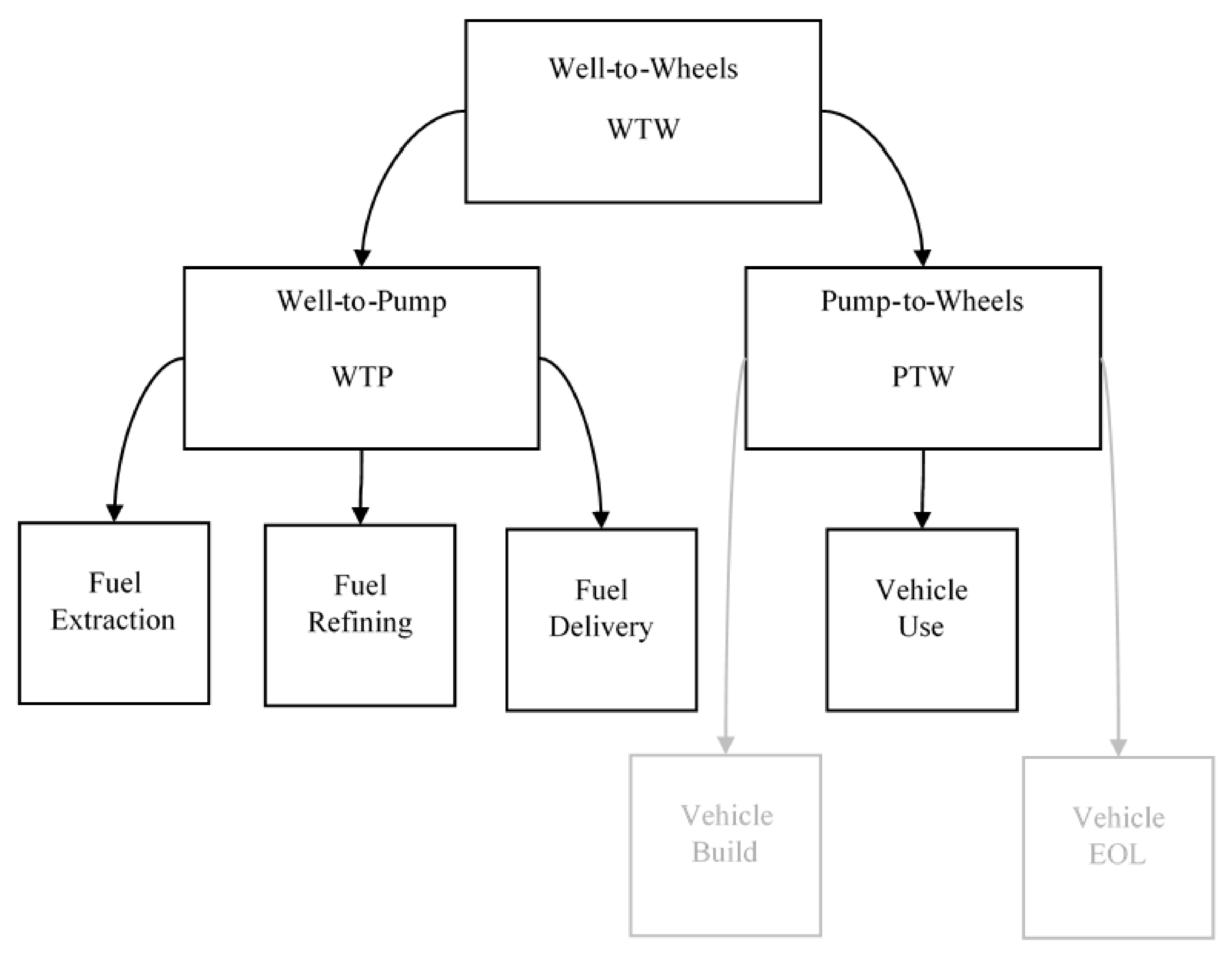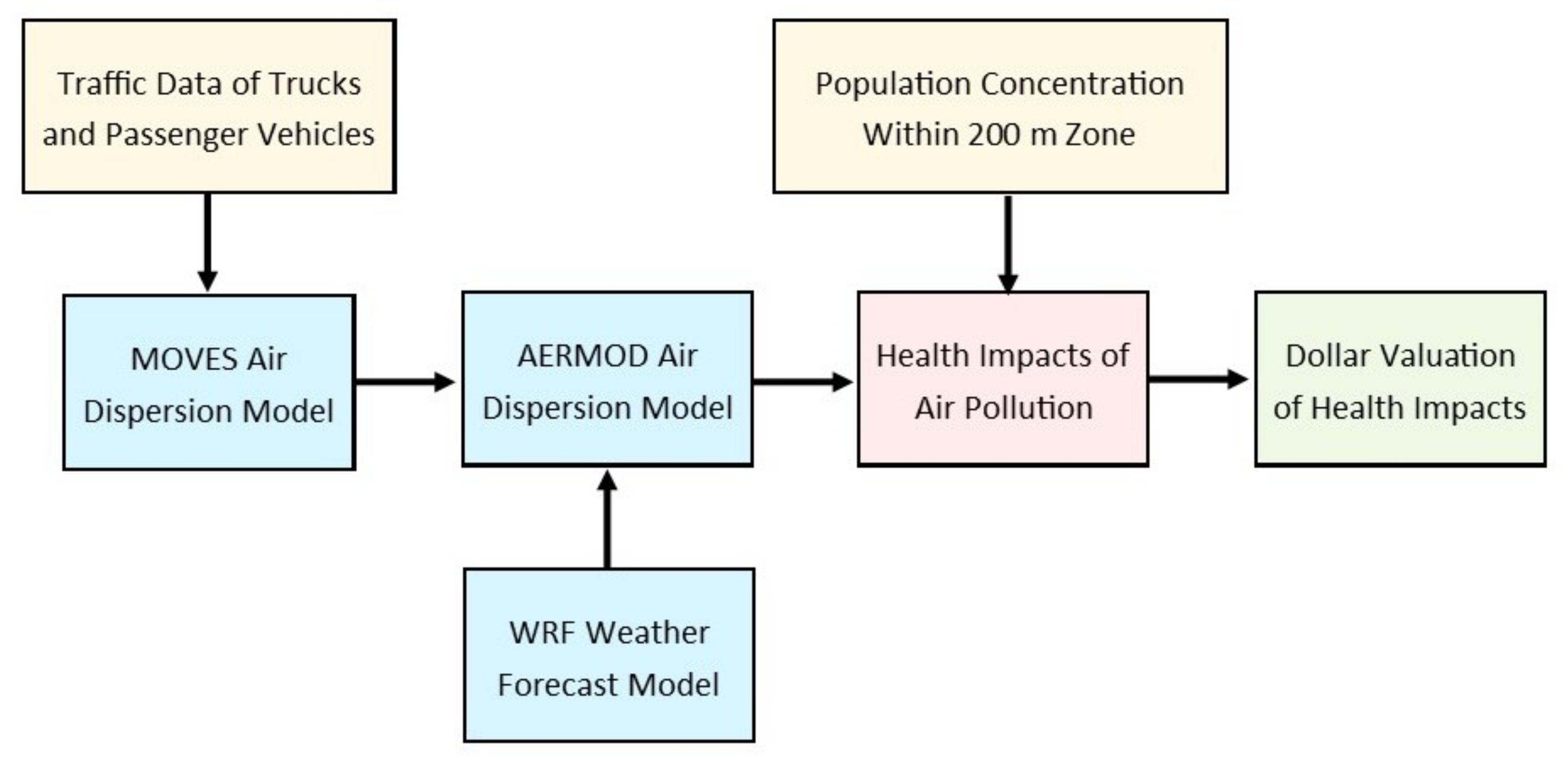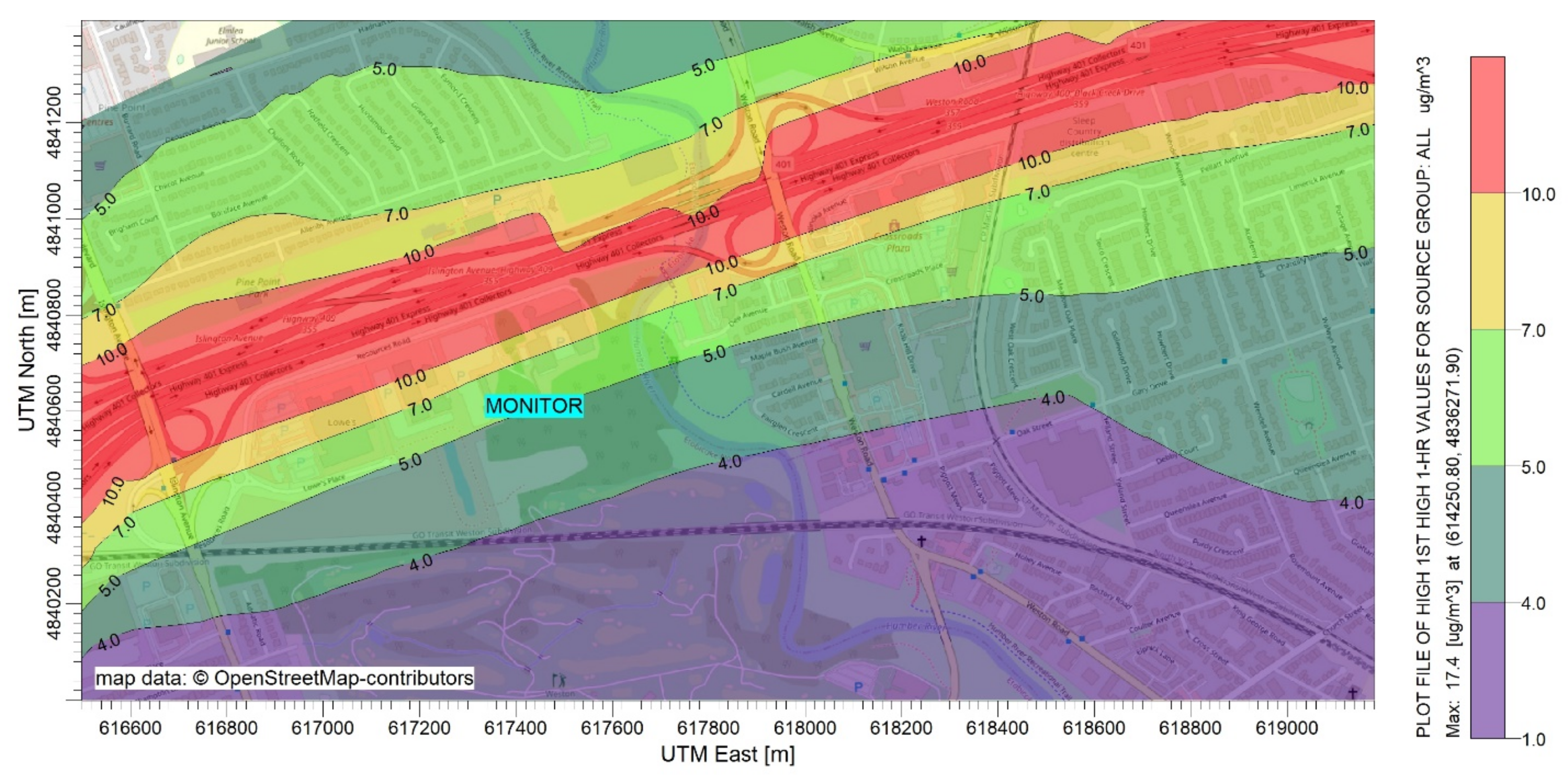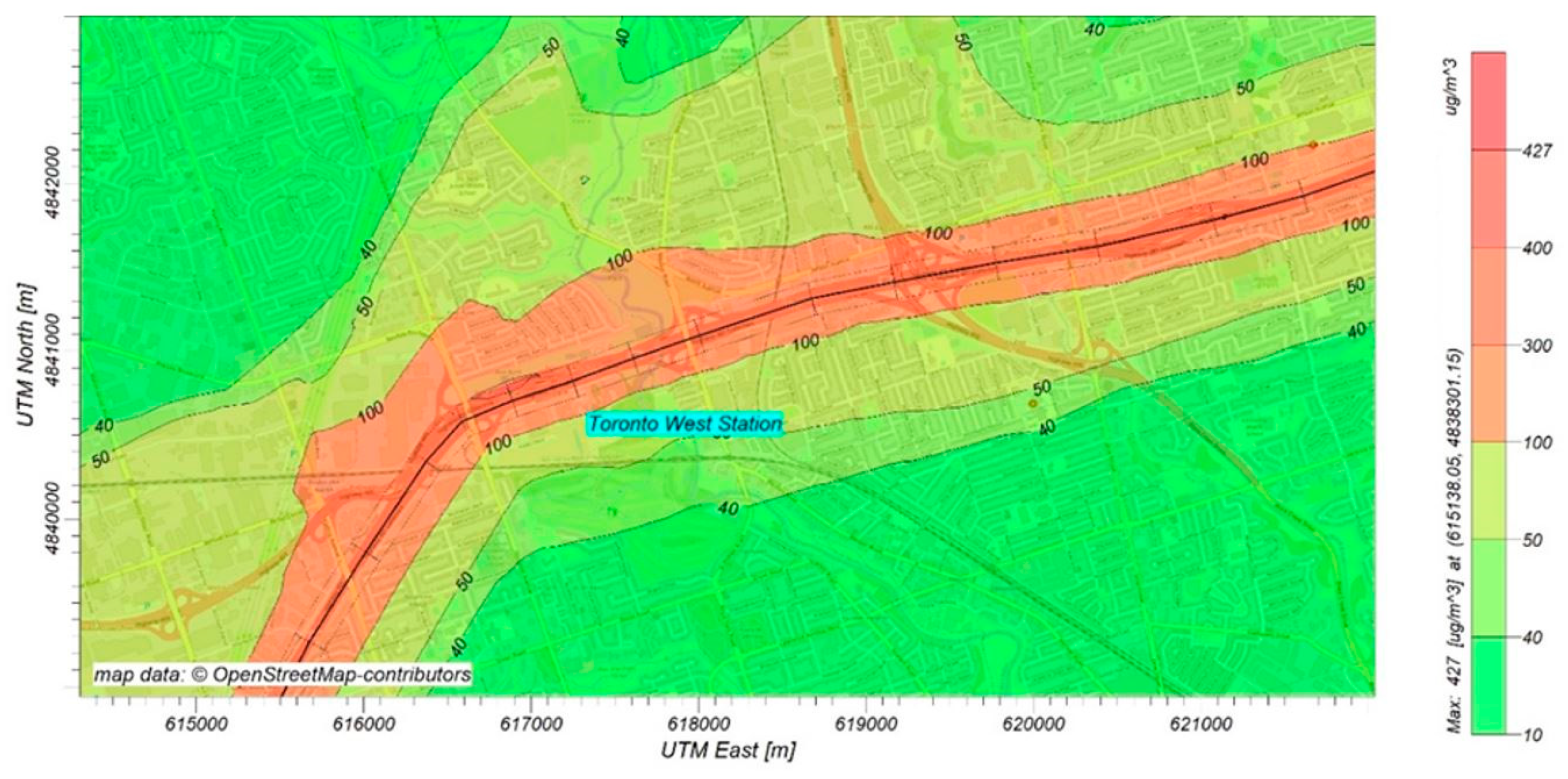Health Cost Estimation of Traffic-Related Air Pollution and Assessing the Pollution Reduction Potential of Zero-Emission Vehicles in Toronto, Canada
Abstract
:1. Introduction
2. Methodology
2.1. Climate Change Cost Calculation
2.2. Health Cost Modeling and Calculation
2.2.1. Total Emissions from Highway 401
2.2.2. Dispersion of Air Pollutants along Highway 401
2.2.3. Risk Analysis
2.2.4. Health Cost Calculation
2.3. Scenarios
3. Results
3.1. Climate Change Cost
3.2. Health Cost
4. Conclusions
Author Contributions
Funding
Data Availability Statement
Acknowledgments
Conflicts of Interest
References
- Shamsi, H.; Haghi, E.; Raahemifar, K.; Fowler, M. Five-year technology selection optimization to achieve specific CO2 emission reduction targets. Int. J. Hydrogen Energy 2019, 44, 3966–3984. [Google Scholar] [CrossRef]
- Haghi, E.; Shamsi, H.; Dimitrov, S.; Fowler, M.; Raahemifar, K. Assessing the potential of fuel cell-powered and battery-powered forklifts for reducing GHG emissions using clean surplus power; a game theory approach. Int. J. Hydrog. Energy 2020, 45, 34532–34544. [Google Scholar] [CrossRef]
- Tran, M.-K.; Akinsanya, M.; Panchal, S.; Fraser, R.; Fowler, M. Design of a Hybrid Electric Vehicle Powertrain for Performance Optimization Considering Various Powertrain Components and Configurations. Vehicles 2021, 3, 2. [Google Scholar] [CrossRef]
- Tran, M.-K.; Sherman, S.; Samadani, E.; Vrolyk, R.; Wong, D.; Lowery, M.; Fowler, M. Environmental and Economic Benefits of a Battery Electric Vehicle Powertrain with a Zinc–Air Range Extender in the Transition to Electric Vehicles. Vehicles 2020, 2, 21. [Google Scholar] [CrossRef]
- Shamsi, H.; Tran, M.-K.; Akbarpour, S.; Maroufmashat, A.; Fowler, M. Macro-Level Optimization of Hydrogen Infrastructure and Supply Chain for Zero-emission Vehicles on a Canadian Corridor. J. Clean. Prod. 2020, 125163. [Google Scholar] [CrossRef]
- Tran, M.-K.; Bhatti, A.; Vrolyk, R.; Wong, D.; Panchal, S.; Fowler, M.; Fraser, R. A Review of Range Extenders in Battery Electric Vehicles: Current Progress and Future Perspectives. World Electr. Veh. J. 2021, 12, 54. [Google Scholar] [CrossRef]
- Brugge, D.; Durant, J.L.; Rioux, C. Near-highway pollutants in motor vehicle exhaust: A review of epidemiologic evidence of cardiac and pulmonary health risks. Environ. Health 2007, 6. [Google Scholar] [CrossRef] [PubMed] [Green Version]
- Gasana, J.; Dillikar, D.; Mendy, A.; Forno, E.; Ramos Vieira, E. Motor vehicle air pollution and asthma in children: A meta-analysis. Environ. Res. 2012, 117, 36–45. [Google Scholar] [CrossRef]
- Aldhafeeri, T.; Tran, M.-K.; Vrolyk, R.; Pope, M.; Fowler, M. A Review of Methane Gas Detection Sensors: Recent Developments and Future Perspectives. Inventions 2020, 5, 28. [Google Scholar] [CrossRef]
- Cohen, A.J.; Ross Anderson, H.; Ostro, B.; Pandey, K.D.; Krzyzanowski, M.; Künzli, N.; Smith, K. The Global Burden of Disease Due to Outdoor Air Pollution. J. Toxicol. Environ. Health Part A 2005, 68, 1301–1307. [Google Scholar] [CrossRef] [PubMed]
- Jerrett, M.; Finkelstein, M.M.; Brook, J.R.; Arain, M.A.; Kanaroglou, P.; Stieb, D.M.; Sears, M.R. A Cohort Study of Traffic-Related Air Pollution and Mortality in Toronto, Ontario, Canada. Environ. Health Perspect. 2009, 117, 772–777. [Google Scholar] [CrossRef] [Green Version]
- Burnett, R.T.; Cakmak, S.; Brook, J.R. The Effect of the Urban Ambient Air Pollution Mix on Daily Mortality Rates in 11 Canadian Cities. Can. J. Public Health 1998, 89, 152–156. [Google Scholar] [CrossRef]
- Brook, J.; Burnett, R.; Dann, T. Further interpretation of the acute effect of nitrogen dioxide observed in Canadian time-series studies. J. Expo. Sci. Environ. Epidemiol. 2007, 17, S36–S44. [Google Scholar] [CrossRef] [PubMed] [Green Version]
- Bai, L.; Shin, S.; Burnett, R.T.; Kwong, J.C.; Hystad, P.; van Donkelaar, A.; Chen, H. Exposure to ambient air pollution and the incidence of congestive heart failure and acute myocardial infarction: A population-based study of 5.1 million Canadian adults living in Ontario. Environ. Int. 2019, 132, 105004. [Google Scholar] [CrossRef]
- Grennfelt, P.; Engleryd, A.; Forsius, M. Acid rain and air pollution: 50 years of progress in environmental science and policy. Ambio 2020, 49, 849–864. [Google Scholar] [CrossRef] [Green Version]
- Pinault, L.; Crouse, D.; Jerrett, M.; Brauer, M.; Tjepkema, M. Spatial associations between socioeconomic groups and NO2 air pollution exposure within three large Canadian cities. Environ. Res. 2016, 147, 373–382. [Google Scholar] [CrossRef]
- Touchaei, A.G.; Akbari, H.; Tessum, C.W. Effect of increasing urban albedo on meteorology and air quality of Montreal (Canada)—Episodic simulation of heat wave in 2005. Atmos. Environ. 2016, 132, 188–206. [Google Scholar] [CrossRef]
- Adams, M.D. Air pollution in Ontario, Canada during the COVID-19 State of Emergency. Sci. Total. Environ. 2020, 140516. [Google Scholar] [CrossRef]
- McCubbin, D.R.; Delucchi, M.A. The Health Costs of Motor-Vehicle-Related Air Pollution. J. Transp. Econ. Policy 1999, 33, 253–286. [Google Scholar]
- Muller, N.Z.; Mendelsohn, R. Measuring the damages of air pollution in the United States. J. Environ. Econ. Manag. 2007, 54, 1–14. [Google Scholar] [CrossRef]
- Martinez, G.; Spadaro, J.; Chapizanis, D.; Kendrovski, V.; Kochubovski, M.; Mudu, P. Health Impacts and Economic Costs of Air Pollution in the Metropolitan Area of Skopje. Int. J. Environ. Res. Public Health 2018, 15, 626. [Google Scholar] [CrossRef] [PubMed] [Green Version]
- Xia, Y.; Guan, D.; Jiang, X.; Peng, L.; Schroeder, H.; Zhang, Q. Assessment of socioeconomic costs to China’s air pollution. Atmos. Environ. 2016, 139, 147–156. [Google Scholar] [CrossRef]
- Lu, X.; Yao, T.; Fung, J.C.H.; Lin, C. Estimation of health and economic costs of air pollution over the Pearl River Delta region in China. Sci. Total. Environ. 2016, 566–567, 134–143. [Google Scholar] [CrossRef] [Green Version]
- Giannadaki, D.; Giannakis, E.; Pozzer, A.; Lelieveld, J. Estimating health and economic benefits of reductions in air pollution from agriculture. Sci. Total. Environ. 2018, 622–623, 1304–1316. [Google Scholar] [CrossRef] [PubMed]
- Nowak, D.J.; Hirabayashi, S.; Doyle, M.; McGovern, M.; Pasher, J. Air pollution removal by urban forests in Canada and its effect on air quality and human health. Urban For. Urban Green. 2018, 29, 40–48. [Google Scholar] [CrossRef]
- Minet, L.; Chowdhury, T.; Wang, A.; Gai, Y.; Posen, D.; Roorda, M.; Hatzopoulou, M. Quantifying the air quality and health benefits of greening freight movements. Environ. Res. 2020, 109193. [Google Scholar] [CrossRef]
- Fiscal Monitor, October 2019: How to Mitigate Climate Change. Available online: https://www.imf.org/en/Publications/FM/Issues/2019/09/12/fiscal-monitor-october-2019 (accessed on 9 January 2021).
- Carbon Pricing Dashboard: Map Data. Available online: https://carbonpricingdashboard.worldbank.org/map_data (accessed on 9 January 2021).
- Motor Vehicle Emission Simulator (MOVES). Available online: https://www.epa.gov/moves (accessed on 26 November 2020).
- Ministry of Transportation Technical Publications: Traffic Volumes. Available online: https://www.library.mto.gov.on.ca/SydneyPLUS/TechPubs/Portal/tp/tvSplash.aspx (accessed on 9 January 2021).
- Air Quality Dispersion Modeling—Preferred and Recommended Models: AERMOD Modeling System. Available online: https://www.epa.gov/scram/air-quality-dispersion-modeling-preferred-and-recommended-models (accessed on 26 November 2020).
- Powers, J.G.; Klemp, J.B.; Skamarock, W.C.; Davis, C.A.; Dudhia, J.; Gill, D.O.; Coen, J.L.; Gochis, D.J.; Ahmadov, R.; Peckham, S.E.; et al. The Weather Research and Forecasting Model: Overview, System Efforts, and Future Directions. Bull. Am. Meteorol. Soc. 2017, 98, 1717–1737. [Google Scholar] [CrossRef]
- Faustini, A.; Rapp, R.; Forastiere, F. Nitrogen dioxide and mortality: Review and meta-analysis of long-term studies. Eur. Respir. J. 2014, 44, 744–753. [Google Scholar] [CrossRef] [PubMed] [Green Version]
- Mortality Rates, by Age Group. Available online: https://www150.statcan.gc.ca/t1/tbl1/en/tv.action?pid=1310071001 (accessed on 9 January 2021).
- The Value of a Statistical Life: Economics and Politics. Available online: https://strata.org/pdf/2017/vsl-full-report.pdf (accessed on 9 January 2021).
- Zhang, A.; Boardman, A.E.; Gillen, D.; Waters, I.I.W.G. Towards Estimating the Social and Environmental Costs of Transportation in Canada. Report for Transport Canada. Available online: http://www.bv.transports.gouv.qc.ca/mono/0965490.pdf (accessed on 25 July 2021).
- Cunanan, C.; Tran, M.-K.; Lee, Y.; Kwok, S.; Leung, V.; Fowler, M. A Review of Heavy-Duty Vehicle Powertrain Technologies: Diesel Engine Vehicles, Battery Electric Vehicles, and Hydrogen Fuel Cell Electric Vehicles. Clean Technol. 2021, 3, 28. [Google Scholar] [CrossRef]















| Input | Description |
|---|---|
| MODELOPT | FASTALL |
| AVERTIME | Annual |
| POLLUTID | PM2.5 and NOx |
| Source type | Line Sources |
| Receptor type | Discrete Cartesian Receptors |
| Domain | Resolution (km) | Number of Grid Points in X and Y |
|---|---|---|
| Domain 1 | 27 | 34 × 34 |
| Domain 2 | 9 | 34 × 34 |
| Domain 3 | 3 | 34 × 34 |
| Scenario | % Electric Passenger Vehicles | % Fuel Cell Trucks |
|---|---|---|
| 1–10% Electric passenger vehicle | 10 | 0 |
| 2–10% Fuel cell trucks | 0 | 10 |
| 3–50% Electric passenger vehicle | 50 | 0 |
| 4–50% Fuel cell trucks | 0 | 50 |
| 5–100% Electric passenger vehicle | 100 | 0 |
| 6–100% Fuel cell trucks | 0 | 100 |
| Portion | Diesel Heavy-Duty Truck | Gasoline Passenger Vehicle |
|---|---|---|
| Eastern | 183,144 | 1,999,776 |
| Central | 384,083 | 4,416,957 |
| West | 530,054 | 5,497,136 |
| Total | 1,097,281 | 11,913,869 |
| Phase | Diesel Heavy-Duty Truck | Gasoline Passenger Vehicle |
|---|---|---|
| Well-to-Pump | 9.8 | 13.5 |
| Pump-to-Wheels | 348.4 | 270.0 |
| Well-to-Wheels | 358.2 | 283.5 |
| Scenario | LCA Type | ||
|---|---|---|---|
| Well-to-Pump | Pump-to-Wheels | Well-to-Wheels | |
| Scenario 1 (10% EV) | 57 | 1196 | 1253 |
| Scenario 2 (10% FC Trucks) | 62 | 1300 | 1361 |
| Scenario 3 (50% EV) | 33 | 727 | 760 |
| Scenario 4 (50% FC trucks) | 61 | 1244 | 1305 |
| Scenario 5 (100% EV) | 4 | 140 | 144 |
| Scenario 6 (100% FC trucks) | 59 | 1174 | 1233 |
| 2016 GHG emission | 63 | 1314 | 1376 |
| Phase | GHG Cost 2016 | GHG Cost of 100% HFCV Semi-Trucks | GHG Cost of 100% Electrified Passenger Cars |
|---|---|---|---|
| Well-to-Pump | CAD 2,510,946 | CAD 2,353,362 | CAD 157,584 |
| Pump-to-Wheels | CAD 52,542,386 | CAD 46,960,153 | CAD 5,582,233 |
| Well-to-Wheels | CAD 55,053,332 | CAD 49,313,515 | CAD 5,739,817 |
| Scenario | Prevented Death Per Year | Prevention of Mortality (CAD Million/Year) |
|---|---|---|
| Scenario 1 (10% EV) | 3 (95% CI 2–4) | 24 |
| Scenario 2 (10% FC Trucks) | 3 (95% CI 2–4) | 24 |
| Scenario 3 (50% EV) | 12 (95% CI 6–18) | 96 |
| Scenario 4 (50% FC trucks) | 14 (95% CI 7–21) | 112 |
| Scenario 5 (100% EV) | 24 (95% CI 12–36) | 192 |
| Scenario 6 (100% FC trucks) | 28 (95% CI 14–42) | 224 |
Publisher’s Note: MDPI stays neutral with regard to jurisdictional claims in published maps and institutional affiliations. |
© 2021 by the authors. Licensee MDPI, Basel, Switzerland. This article is an open access article distributed under the terms and conditions of the Creative Commons Attribution (CC BY) license (https://creativecommons.org/licenses/by/4.0/).
Share and Cite
Shamsi, H.; Munshed, M.; Tran, M.-K.; Lee, Y.; Walker, S.; The, J.; Raahemifar, K.; Fowler, M. Health Cost Estimation of Traffic-Related Air Pollution and Assessing the Pollution Reduction Potential of Zero-Emission Vehicles in Toronto, Canada. Energies 2021, 14, 4956. https://doi.org/10.3390/en14164956
Shamsi H, Munshed M, Tran M-K, Lee Y, Walker S, The J, Raahemifar K, Fowler M. Health Cost Estimation of Traffic-Related Air Pollution and Assessing the Pollution Reduction Potential of Zero-Emission Vehicles in Toronto, Canada. Energies. 2021; 14(16):4956. https://doi.org/10.3390/en14164956
Chicago/Turabian StyleShamsi, Hamidreza, Mohammad Munshed, Manh-Kien Tran, Youngwoo Lee, Sean Walker, Jesse The, Kaamran Raahemifar, and Michael Fowler. 2021. "Health Cost Estimation of Traffic-Related Air Pollution and Assessing the Pollution Reduction Potential of Zero-Emission Vehicles in Toronto, Canada" Energies 14, no. 16: 4956. https://doi.org/10.3390/en14164956
APA StyleShamsi, H., Munshed, M., Tran, M.-K., Lee, Y., Walker, S., The, J., Raahemifar, K., & Fowler, M. (2021). Health Cost Estimation of Traffic-Related Air Pollution and Assessing the Pollution Reduction Potential of Zero-Emission Vehicles in Toronto, Canada. Energies, 14(16), 4956. https://doi.org/10.3390/en14164956











